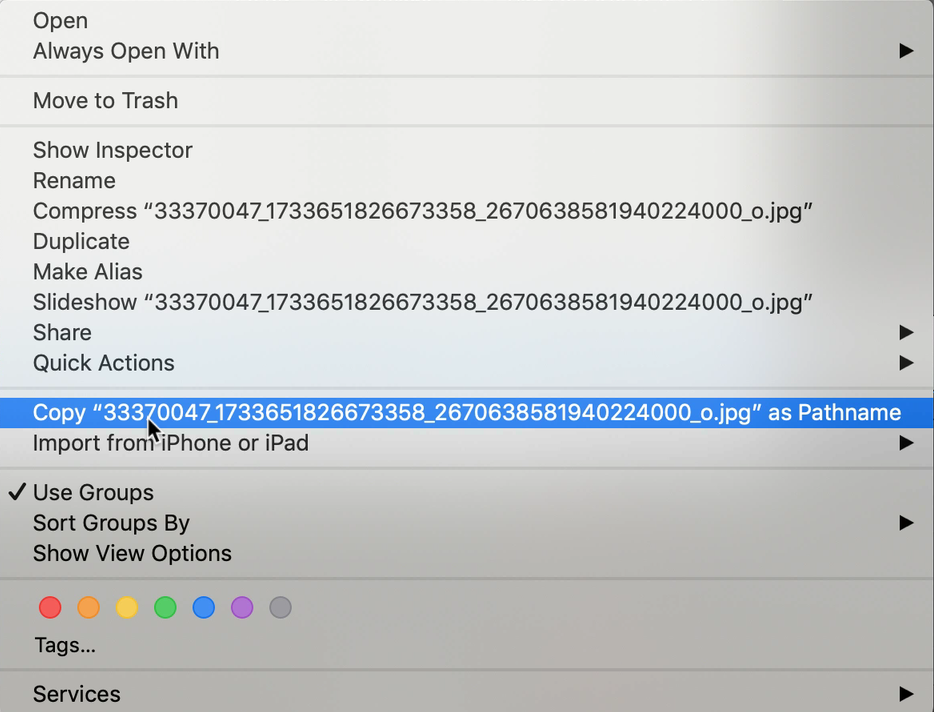

- GET FILE PATH IN MAC HOW TO
- GET FILE PATH IN MAC PDF
- GET FILE PATH IN MAC FULL
- GET FILE PATH IN MAC SOFTWARE
You can use one of several techniques in the Finder, in the document window, or while searching.

GET FILE PATH IN MAC FULL
Now you have the path, as text, in your clipboard. 10 Ways To Get a File Path On a Mac If you need to see or copy the full path to a file, there are many ways to do it on a Mac. To copy a file or folder's path in Finder.app: Right-click the item. I've found it to be both stable and useful, if perhaps a bit finicky about how it's scripted. In macOS holding the ALT key often shows extra options in context menus. It's similar to Applescript in that respect, but it essentially uses the power of terminal packaged in simple menu commands. Pretty much anything you want to do can probably be figured out.
GET FILE PATH IN MAC PDF
For example, I have menu items that allow me to create a text file in the current directory (usually the Desktop) by selecting "New text File.", create a disk image where ever I am, list the full contents and permissions of whatever directory I'm in, put all selected items into a new folder, move a file or folder directly to avoid drag and drop tedium, etc.Īlso, depending on the file type of the selected item you can also do interesting things like convert an image to a different format, open a text file directly in the editor of your choice, merge multiple PDF files into one PDF, etc.
GET FILE PATH IN MAC HOW TO
If you know how to use a terminal you can write your own commands as well. Example 2: Create File Path Using file.path() Function. It adds functionality to the menu (under the "More" drop down menu) that you see when you ctrl-click a file (or just anywhere), and one of them is "Show path." When you select it it shows a terminal window with the current path and automatically copies it to the clipboard. The previous code works on Microsoft Windows, as well as on Apple macOS, and Linux. (You can also double-click on a folder or subfolder displayed in the path bar to open that folder and see its contents in the main part of the window.) The option for showing or hiding the path bar is under the Finder’s own View menu.There is a contextual menu plugin that you may be interested in called On My Command, or just OMC for short. After the contextual menu appears (and only after), add the Option key and then select Copy file name or folder name as Pathname. Click an item in your results list to see the location of the file and its enclosing folders in the path bar at the bottom of the Finder window. Control- or right-click a file or folder. You can also just select the file and then press Opt-Cmd-C to copy the pathname to the clipboard. You can narrow your search with the window’s drop-down menu, which lets you filter by file type and other criteria. Ctrl -click (or two finger click) on the file you want the path from, then press Opt and select 'Copy as path name' (or what its called in english) from the context menu. When the Finder window opens, enter your keywords in the search box in the upper-right corner. Terminal with then display the full path to the file.

To search for a file using Finder, click the Mac’s desktop background and press the Command and F keys on the keyboard you can also get there by clicking the File menu on the Mac’s toolbar and selecting Find. If you have the file in finder you can open a terminal window and drop the file into it. You can search for files by name, kind, size, date or even keywords within a file’s content.
GET FILE PATH IN MAC SOFTWARE
Apple’s annual updates to its OS X operating system often bring changes to the way the software functions, but in OS X 10.11 (El Capitan), you can still search for files using either the desktop Finder or the Spotlight tool. How can I search for files and folders in this version of OS X?Ī. I knew how to do it in OS X 10.9, but my computer is now upgraded to OS X 10.11 and the instructions I have don’t work anymore. I am trying to figure out how to find the folders on my Mac that hold certain documents.


 0 kommentar(er)
0 kommentar(er)
